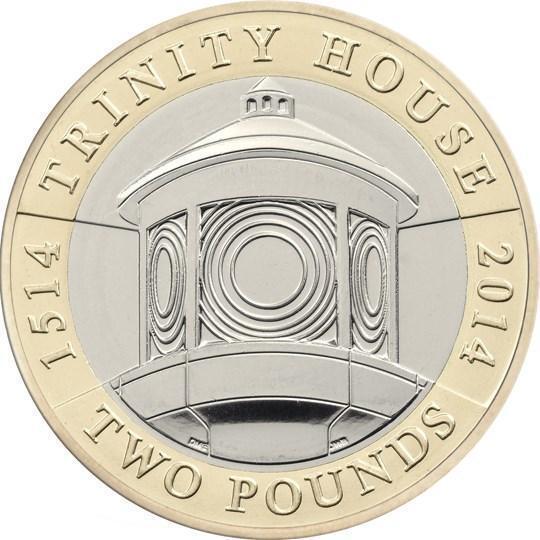The world of numismatics is a fascinating one, where coins become more than mere currency - they transform into tangible pieces of history. Among these remarkable coins, the 2014 Trinity House £2 coin stands as a beacon, commemorating a venerable institution and celebrating centuries of maritime safety. Let’s delve into the nautical depths and explore the story behind this coin.
The Trinity House is no ordinary organisation. Established in 1514 by Royal Charter granted by King Henry VIII, it has safeguarded shipping and boating in England, Wales, the Channel Islands, and Gibraltar for five centuries.
Its original name—The Master, Wardens and Assistants of the Guild Fraternity or Brotherhood of the most glorious and undivided Trinity and of St. Clement in the Parish of Deptford Strond in the County of Kent—may be a mouthful, but its mission was clear: to regulate boat traffic, ensure pilot behavior, and maintain safety on the Thames.
The Lighthouse Beacon: A Symbol of Guidance
The 2014 Trinity House £2 coin celebrates the 500th anniversary of this venerable institution. Designed by artists Joe Whitlock Blundell and David Eccles, the coin captures the essence of maritime guidance.

Let’s break down its design:
The Lighthouse Beacon: At the heart of the coin stands a lighthouse beacon. Its light shines out in both directions, symbolizing the safety it provides to mariners navigating treacherous waters. The indentations on the coin’s surface represent this radiant beam extending toward the edges.
Encircling the image are the inscriptions: “1514 TRINITY HOUSE 2014 TWO POUNDS.” These dates bookend the institution’s remarkable journey across half a millennium.
The initials of the artists are engraved subtly into the design. DME (David Eccles) appears on the left, just above the “O” in “TWO.” On the right, JWB (Joe Whitlock Blundell) rests above the “UN” in “POUNDS.
A Coin of Maritime Legacy
The 2014 Trinity House £2 coin transcends mere currency. It encapsulates centuries of maritime dedication, guiding ships through tempests and tides. As you hold this coin, imagine the lighthouse’s beacon cutting through darkness, offering hope and safety to mariners—a legacy that endures across oceans and time.
So, whether you find it in your pocket change or seek it out as a collector, remember that within its metal lies a story of service, navigation, and the enduring spirit of the sea
The Fourth Portrait of Queen Elizabeth II, in this iteration facing right, is depicted on the coin's obverse. From 1998 to 2015, this design was featured on the two pound coin.

Her Majesty's grandmother, Queen Mary, gave her the diamond tiara known as the "Girls of Great Britain and Ireland" as a wedding present in 1947.
Her image is immediately followed by the letters IRB, which stand for the initials of artist Ian Rank-Broadley.
The famous ELIZABETH II DEI GRA REG FID DEF, which translates from Latin to read Elizabeth the Second, by the Grace of God, Queen, Defender of the Faith, is inscribed around her head and all the way around the outer circle.
Just underneath her portrait, the artist Ian Rank-initials, Broadley's IRB, may be seen. Her illustrious ELIZABETH II DEI GRA REG FID DEF, which translates from Latin to mean Elizabeth the Second, by the Grace of God, Queen, Defender of the Faith, surrounds her head all around the outer circle.
After the coin went decimal, this particular portrait was on the two pound coin from 1998 until 2015.
Mintage of the Coin
The Royal Mint's official mintage of this £2 commemorative coin is 3,705,000
The Trinity House £2 coin holds historical weight. Its mintage of 3,705,000 places it in the realm of common circulation coins. For context, this mintage is similar to the 2009 Charles Darwin £2 coin, or the 2009 Robert Burns £2 coin.
Collectors’ Versions: A Glimpse into Rarity
While the circulating version is accessible, collectors have their eyes on rarer editions:
-
Brilliant Uncirculated (BU): A version presented in a collectors’ folder, with a mintage of 24,386. Valued between £10 and £50.
-
Proof First Day Cover: Limited to 14,124, this version commands around £50.
-
Silver Proof: Only 1,936 minted, with an estimated value of £100 to £150.
-
Silver Proof Piedfort: A thicker silver version, rarer at 1,139, fetching around £300.
-
Gold Proof: The pinnacle of rarity, with a mintage of 279, its estimated value ranges from £1,000 to £2,000.
Scarcity of the coin
In 2014, two commemorative £2 coins were made available, The Kitchener £2 coin and the 2014 Trinity House £2 coin, along with the Technology coin which had a mintage of 18,200,000. One commemorative 50p coin, the 2014 Glasgow Commonwealth Games 50p, was also released in this year.
The 2013 Trinity House £2 coin has an average mintage and it is likely you have received one of these coins in your change, so it is not considered to be a particularly rare coin. The likelihood of receiving one in your change is about 1 in 500 of the £2 coins received.
How much is the 2014 Trinity House Two Pound coin worth?
The coin in common circulating condition is worth around £4.20 without shipping, which is considerably more than face value and the values increasing.
Where can I buy the 2014 Trinity House £2 Coin?
You can buy this coin by clicking here.
You can buy the circulated version of the Trinity House £2 coin online on auction sites such as eBay or Amazon but please ensure you look at all the information and reputation of the seller.
Unfortunately, as this coin is now over 10 years old, the Royal Mint no longer stock this coin so it is only available to buy on the secondary market.
Are there any known errors of this coin?
The Royal Mint has not confirmed any official errors for this coin so please beware of any sellers trying to inflate the selling price by claiming they have an error coin.
The writing on the side of the coin can be either one way or the other and there is an equal chance of it being either upside down or the other way, it is not an error.
Bit of trivia...
Why are lighthouses different colours and heights?
Lighthouses are painted differently to help identification of them by the mariner during the day. For example, a lighthouse may be painted all white if its surroundings/background is dark, such as fields or woodland. This will help it stand out from its background. The red and white stripes help the mariner identify the lighthouse if the lighthouse is up against a white background, such as cliffs or rocks.
The height of a lighthouse takes into account the curvature of the earth, so the higher light above MHW (mean high water), the further away it can be seen at sea. But the light should not be so high up that local sailors will not see it. It is possible that a sailor sitting a mile or so out at sea may not see the light if the beam is too high. Hence, you will frequently get shorter lighthouses on the top of cliffs and taller lighthouses built nearer the water surface.
The actual shape of the lighthouse often depended upon the whim of the individual designer, which is why there are some that look like traditional lighthouses whereas others look like castles.
Additionally lighthouses in fairly close proximity to each other have different flash patterns (or characteristics) to allow the mariner to visually identify their location as well as relying on their technical equipment on board. Some lighthouses in different geographical areas (e.g. east and west coast) share the same flash patterns.

